Physical Factors
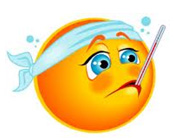
Illness can:
- Impair a person’s ability to transmit visual and auditory information to the brain.
- Impair the ability of the brain to act on this information.
- Impair a driver’s ability to rapidly take corrective action during emergency situations.
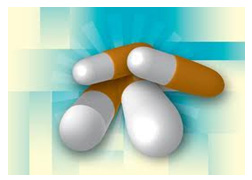 Certain prescription and over-the-counter medications taken for illness, even common cold medications, can cause the driver to become drowsy while driving. You should be very careful if you choose to drive when you are feeling ill. You are responsible for knowing the effects the medications you take have on your driving ability.
Certain prescription and over-the-counter medications taken for illness, even common cold medications, can cause the driver to become drowsy while driving. You should be very careful if you choose to drive when you are feeling ill. You are responsible for knowing the effects the medications you take have on your driving ability.
If you are ill, stay home and rest. Do not drive on the roadway, especially if you are taking medications that cause drowsiness.
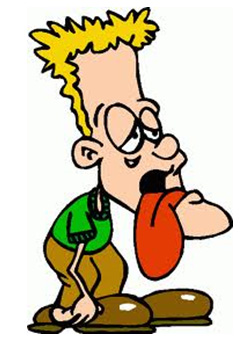 Physical and mental fatigue also increases the likelihood of crashes by affecting your vision, judgment and reaction time.
Physical and mental fatigue also increases the likelihood of crashes by affecting your vision, judgment and reaction time.
- Falling asleep is the primary factor in about 1% of fatal and injury collisions in California.
- Driving when you are tired is just as dangerous as driving when you have been drinking alcohol. When you are tired, you are less alert and may not see hazards early enough to react quickly. If you are tired, get off the road and get some sleep.
Psychological Factors
Some psychological factors can also lead to accidents such as: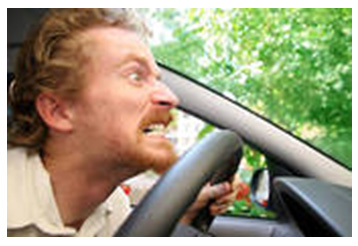
- Being emotionally distressed or tense
- Being distracted by personal problems or environmental conditions inside and outside your vehicle
- Having inadequate training and practice.
Safe driving requires concentration. If you are preoccupied with your emotions, you will not be able to focus on the task of driving safely.
Environmental Distractions
Conditions inside of your vehicle can also cause you to drive unsafely. For example: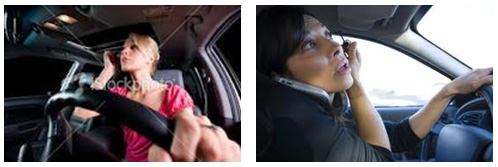
- Distracting passengers
- Loud music
- Doing other things while driving
- Using cell phone
Alcohol and Drugs
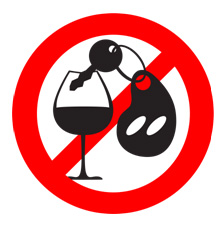 Alcohol and drugs are the primary collision factor in about 9% of fatal and injury accidents in California. Alcohol, illegal drugs, prescription drugs and over-the-counter medications can impair your vision, judgment and reaction time
Alcohol and drugs are the primary collision factor in about 9% of fatal and injury accidents in California. Alcohol, illegal drugs, prescription drugs and over-the-counter medications can impair your vision, judgment and reaction time
Driver Behavior
The following are common driver behaviors that lead to collisions.
Inattentiveness
- You could find yourself involved in a collision when not keeping your eyes on the road or losing your concentration even for just a second. One second not looking at the road means one fewer second that you have to react to emergency situations.
- To avoid being distracted while driving:
- Do not play your radio too loud.
- Refrain from changing CDs or radio stations
- Plan your trips by mapping your destination and having enough travel time.
- Refrain from using your cell phones or other digital devices
Poor visual scanning
- When you drive, keep your eyes moving and look for potential hazards around your vehicle. Do not focus only the back of the car ahead of you. Do not assume anything.
- Scanning the roadside helps you to see:
- Vehicles and pedestrians that may be in the roadway by the time you reach them.
- Warning signs for potential hazards ahead
- Signs that gives you directions.
- Remember to keep your eyes moving. Be aware of your surroundings near and far. Turn your head before changing lanes to check your blind spots. Be prepared and watch for potential emergency situations. Be aware of traffic signs or any warning signs for upcoming road conditions.
- Be aware of vehicles, pedestrians and objects around your vehicle when slowing down, merging, changing lanes, passing, or making a turn. Check your mirrors and blind spots before attempting any of these maneuvers. If you cannot see the roadway ahead because of a large vehicle, such as a truck or SUV, make sure to give yourself additional space in front of your vehicle so you can react in an emergency situation. You may want to change lanes, when it is safe, so that you can see what is going on ahead of you.
Making poor decisions
Making a poor decision while driving can also result in an accident. Poor decisions can result from:
- Not knowing the law
- Disregarding the law
- Taking unnecessary risks
Inability to handle a vehicle in emergency situations
- The key to becoming a safe driver is learning the appropriate ways to react to different emergency situations in a split second and making the appropriate decisions.
- Collisions happen because drivers do not expect and prepare for these situations and do not know how to properly react to them.
- The best ways to avoid a collision is to:
- Anticipate hazards
- Be ready to respond
- Know the handling characteristics and limitations of your car
- Remain calm
- Think before Slamming on your brakes. It is not the best reaction to every driving emergency.
Skids
- Not understanding how to handle your vehicle in emergency situations may result in skidding that can cause a crash. Skids occur whenever tires lose their grip on the road. Certain road and weather conditions are particularly likely to cause your vehicle to skid.
- Skids are caused by:
- Over-braking
- Over-steering
- Over-acceleration
- Avoid driving too fast as it results in the need to over-brake and over-steer.
- The key to avoiding skids is to:
- Smoothly apply your brakes and accelerator
- Turn slowly and smoothly
- If your car starts to skid, immediately remove your foot from the gas pedal and turn into the skid.

Tailgating
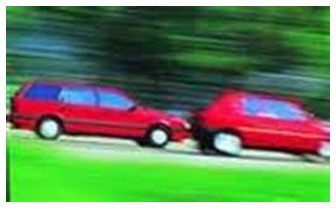 Tailgating is indicated as the primary collision factor in about 3% of all fatal and injury accidents in California.
Tailgating is indicated as the primary collision factor in about 3% of all fatal and injury accidents in California.
- If you are following another vehicle too closely (tailgating), you will not be able be to see hazards ahead of you as easily and you will have less time to stop or slow down in an emergency situation.
- Tailgating is particularly risky and dangerous on freeways because vehicles are usually traveling faster. In some instances, drivers slow down needlessly to look at broken down vehicles and other scenes, which is called rubbernecking. Rubbernecking and tailgating are a dangerous mix which leads to rear-end collisions.
- Best Practice: allow enough space in front of your vehicle to stop safely.
- You should always keep a minimum of a 3-second gap in front of your vehicle. To do so, pick a fixed object on the roadway such as a sign or pavement marking and count the seconds from when the vehicle ahead of you passes the object and to when you reach the object. If it is not at least 3 seconds, you need to slow down and increase your following distance.
Unsafe passing
- Be extra careful and aware when passing other vehicles on two-lane roads since passing will put you on the wrong side of the road.
- Before attempting to pass, you need to make sure that:
- Passing is not prohibited by a sign or pavement marking
- Your view of oncoming traffic is not obstructed by a turn, hill or object.
- You have enough space in oncoming traffic to pass the other vehicle safely.
- Passing several cars at one time is particularly dangerous.
- If another driver wants to pass you, be courteous and let them do so. Do not speed up in passing lanes. Use turnout lanes when possible so that others may pass you safely.
Driving too fast
- Speed is indicated as the primary factor in about 28% of fatal and injury collisions.
- When you drive faster than it is safe under the current condition:
- You have less time to react to road hazards
- It will take you longer to stop your vehicle
- You will suffer greater impact and injuries if a collision occurs.
Note: The basic speed law in California says that no person shall drive a vehicle upon a highway at a speed greater than is reasonable or prudent having due regard for weather, visibility, traffic conditions and the surface width of the highway, and in no event at a speed which endangers the safety of persons or property.
- In general, it is unsafe and illegal to drive faster than the posted speed limit. However, driving too slowly can also be unsafe and cause an accident.
Improper turns
- Making an illegal or otherwise improper turn is the primary collision factor in about 9% of fatal and injury collisions in California.
- A turn is when a driver wants to maneuver their vehicle to another street, building, exit, road, store, center, etc. This is most common at intersections where drivers want to turn in a different direction.
- Safety rules to avoid a collision while turning.
- Make your turns only when you can see clearly that it is safe
- Signal 100 feet before the corner to let the other drivers know that you will be turning.
- Look for pedestrians and bicyclists.
- Yield to vehicles already in the intersection.
- Make sure you can see before crossing an intersection.
- Look 10 to 15 seconds ahead (one block ahead)
Left Turns
Left turns are much more dangerous than right turns as they require crossing opposing traffic. Judging the distance needed to turn left in front of oncoming traffic will be challenging to new drivers. Extra caution must be taken. Proceed only when you feel it is safe.
- To make a left turn
- Be in the proper lane first. Determine if there is a left turning lane; if so use it, if not use the lane closest to the center of divider.
- Signal your intentions 100 feet before the junction.
- Make a complete stop.
- Wait until you have the right- of-way and then turn into your intended lane.
Note: If there is more than one lane to turn left, you must stay in the lane that you have started in and remain in the same lane throughout your turn.
Right Turns
- Although right turns do not require crossing any traffic they too, can be dangerous especially on busy streets. Beware of pedestrians and bicyclists. Remember that all pedestrians and bicyclists have the right-of-way! Check the pedestrian lights (WALK/DO NOT WALK) and never assume a pedestrian will not step off a curb in front of you.
- Turning right on red light is legal, unless a sign prohibits it. Make sure to stop completely before the limit line before making your turn. Be careful that you do not interfere with pedestrians, bicyclists and vehicles moving through the intersection on their green light or drivers turning left from the opposing traffic’s left turning lane on their green light.
- When turning right, you may use the bike lane only if it is clear of bicyclists and only when you are 200 feet from the intersection.
Left turn from a two-way street (#1)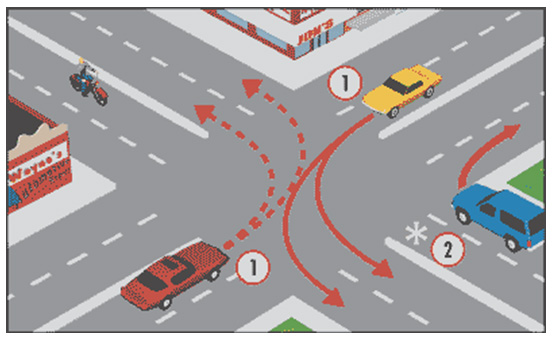
- Start the turn in the left lane closest to the middle of the street.
- Complete the turn in either lane of the cross street (shown by arrows), if safe.
- Use the center left turn lane if there is one.
- A left turn may be made from the other lane, if permitted by signs or arrows.
Right turn (#2)
- Begin and end the turn in the lane nearest the right hand curb.
- Do not swing wide into another lane of traffic.
- Watch for bicyclists between your vehicle and the curb.
- Sometimes, signs or pavement markings will let you turn right from another lane (shown by * below).
Left turn from a two-way street into a one-way street (#3)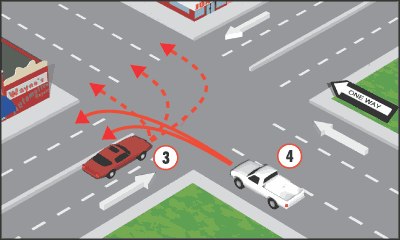
- Start the turn from the lane closest to the middle of the street.
- Turn into any lane that is safely open, as shown by the arrows.
Left turn from a one-way street into a two-way street (#4)
- Start the turn from the far left lane.
- Turn into either of the lanes that are safely open, as shown by the arrows.
Left turn from a one-way street into a one-way street (#5)
- Start the turn from the far left lane.
- Watch for bicyclists between your vehicle and the curb because they can legally use the left turn lane for their left turns.
- Turn into any lane that is safely open, as shown by the arrows.
Right turn from a one-way street into a one-way street (#6)
- Start the turn in the far right lane.
- If safe, you may end the turn in any lane.
- Sometimes, signs or pavement markings will let you turn right from another lane (shown by *)
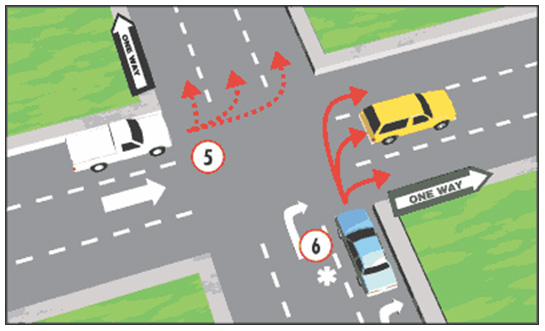
Turn at a T intersection from a one-way street into a two-way street (#7)
- Through traffic has the right of way. You may turn either right or left from the center lane. Watch for vehicles and bicyclists inside your turn.
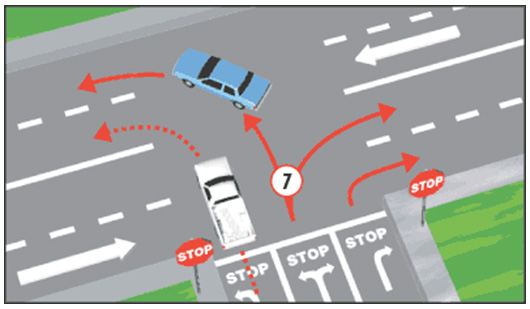
Center Left Turn Lanes
- A center left turn lane is in the middle of a two-way street and is marked on both sides by two painted lines. The inner line is
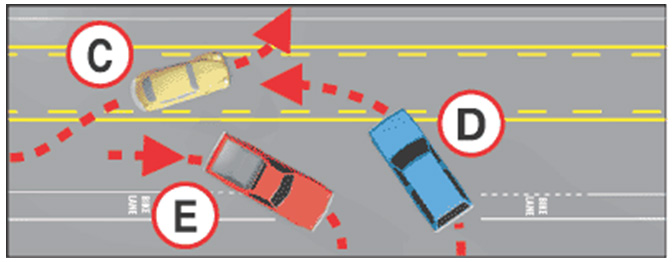 broken and the outer line is solid.
broken and the outer line is solid. - If a street has a center left turn lane, you must use it when you turn left or start a permitted U-turn.
- You may only drive for 200 feet in the center left turn lane. This lane is not a regular traffic lane or a passing lane.
- To turn left from this lane, signal and drive completely inside the center left turn lane. Do not stop with the back of your vehicle blocking traffic.
- Make sure the lane is clear in both directions and then turn only when it is safe.
- Look for vehicles coming toward you in the same lane that are also making their left turn.
- When turning left from a side street or driveway, signal and wait until it is safe. Then drive into the center left turn lane. Enter traffic only when it is safe.
Simultaneous Turns
- The first type of simultaneous turn is one in which two or more lanes are turning from the same side of the road, in the same direction. When a driver is making this kind of simultaneous turn, the driver must remain in the proper lane from start to finish. If you are in the second left turn lane from the center divider, you must stay within the second lane of the street you are turning into.
- The second type of simultaneous turn is one in which when two opposing left or right turn lanes are able to turn by using the intersections left or right control signal. This occurs when the two opposing traffic signals indicate that a north bound lane may turn left while the opposing signal indicates to the south bound lane as well that they may make their left turn, all of which happens at the same time.
U-Turns
A U-turn is the turning of a vehicle upon a roadway to proceed in the opposite direction. Many intersections have NO U-TURN signs as there is not enough room to safely complete the turn at that intersection or oncoming traffic moves too fast to safely complete the turn. Always make a U-turn from the leftmost lane. You must yield to all oncoming traffic and watch for drivers turning right while you are making your U-turn.
Improper lane changes
- Improper lane changes are the primary collision factor in about 4% of fatal and injury accidents in California.
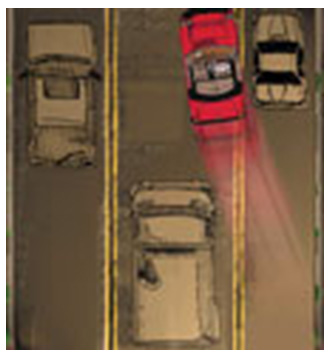
- When you change lanes, you have to do more than just signal and check your mirrors. You must also turn your head and look into the lane that you want to enter. Remember that you have blind spots which limit your ability to see vehicles to the sides of you.
- You must yield to vehicles that are already in the lane you want to enter. They do not “have” to make room for you to merge and you should never assume that they will.
- You should avoid making last minute lane changes to catch an exit or to make a turn. Plan ahead and make your lane change(s) well in advance to avoid causing an accident.
- When you are making a lane change, do not forget to keep an eye on traffic in front of you and behind you in the lane in which you are driving. If you are not paying attention to traffic in your lane, you may rear-end the vehicle in front of you or hit other vehicles also trying to enter the lane you want to enter. Be aware of other vehicles that may be trying to enter the same lane as you.
- Do not cross over multiple lanes or over solid white lines when making a lane change. It is both dangerous and illegal. For instance, when you are driving on a five-lane freeway closest to the center divider and going to exit the freeway, you should change lanes one at a time until you are in the proper lane.
Failing to obey stop signals and signs
- Failure to obey a stop sign or signal is the primary collision factor in about 9% of fatal and injury collisions in California.
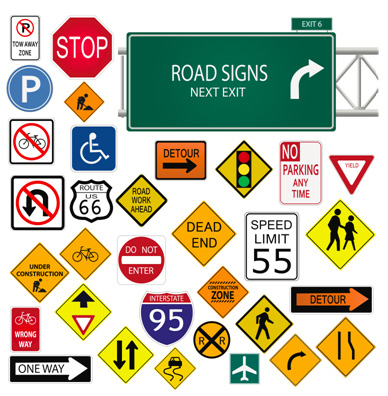
- Stop signs and red lights mean you should completely stop your vehicle behind the limit line, crosswalk, or before the intersection.
Note: Every time you stop, you should feel your body move slightly forward and then backwards. This is because you are breaking the force of inertia on your body that makes it keep moving forward even though the vehicle is slowing down. If you do not feel yourself move backwards against your seat, you have not stopped completely
- Intersections are the most common place where collisions occur in urban areas. This is because vehicles moving in different directions of travel meet at intersections and pedestrians are often added to mix.
- Remember that you should stop at a yellow signal light if you can do so safely.
Failing to yield the right-of-way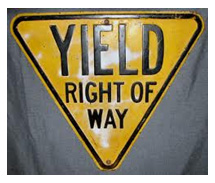
- Failure to yield the right-of-way to another vehicle or pedestrian is the primary collision factor in about 20% of fatal and injury collisions in California.
- The two major mistakes that drivers make regarding right-of-way are assuming that other drivers will give them the right-of-way and failure to yield the right-of-way to others. You should never assume that another driver will yield the right- of-way to you and you should never insist on taking the right- of-way. This practice often helps you avoid collisions.
Driving on the wrong side of the road
- Driving on the wrong side of the road is the primary collision factor in about 4% of fatal and injury collisions in California.
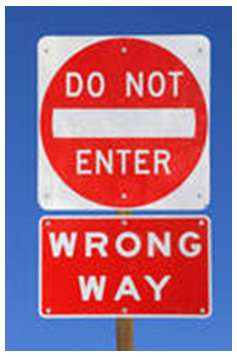
- Driving on the wrong side of the road results most often in head-on crashes. This type of crash is classified as the most dangerous of all accidents.
- You should be able to determine whether you are on the wrong side of the road by the color of the lines painted on the pavement. If there is a yellow line on your right or if there is not one on your left, you are on the wrong side of the road.
- Look for WRONG WAY and DO NOT ENTER signs when making left and right turns into traffic. These signs warn you that you are driving towards oncoming traffic.

